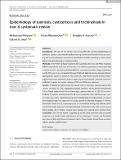| dc.description.abstract | Abstract
Background: The aim of this review was to establish the current epidemiology of
taeniosis, cysticercosis and trichinellosis among humans and animals in Iran by carry‐
ing out a comprehensive assessment of published articles reporting on these food‐
borne zoonotic diseases across the country.
Methods: The Preferred Reporting Items for Systematic Reviews and Meta‐Analyses
(PRISMA) guideline was used in the search for relevant published articles reporting
on cysticercosis, taeniosis and trichinellosis in Iran using a number of appropriate key
words. The search was conducted through PubMed, Web of Science, Google Scholar,
SpringerLink, SCOPUS, WHOLIS, FAO and CDC. Published scientific articles includ‐
ing journals, books and book chapters reporting on cysticercosis, taeniosis and trich‐
inellosis in Iran for the period between 1967 and 2018 were selected.
Results: A total of 37 articles met the search criteria and were incorporated in this
review. Of these, 10 (27%) reported on human taeniosis, 15 (40.5%) on cysticercosis
(10 on Taenia saginata and five on Taenia spp. cysticercosis) and 12 (32.5%) on trich‐
inellosis. T. saginata was implicated in all human taeniosis cases. All Taenia spp. cyst‐
icercosis cases were reported among domesticated pigs and wild animals. A case of
neurocysticercosis was reported in a male patient at Shohada Hospital in Tehran.
Eleven (91.7%) of the 12 studies reported on trichinellosis among wild animals, while
one (8.3%) study detected anti‐Trichinella IgG in 8 (2.2%) of the 364 at‐risk human
beings tested. Nevertheless, most of these studies were carried out in northern Iran.
Conclusion: This review found T. saginata to be the most prevalent and of greater
economic and public health significance in Iran. However, T. solium and Trichinella
spp. were of little significance to human health. More studies should focus on other
regions besides northern Iran | en_US |

